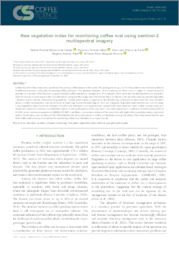New vegetation index for monitoring coffee rust using sentinel-2 multispectral imagery.
New vegetation index for monitoring coffee rust using sentinel-2 multispectral imagery.
Author(s): CASTRO, G. D. M. de; VILELA, E. F.; FARIA, A. L. R. de; SILVA, R. A.; FERREIRA, W. P. M.
Summary: Coffee Rust (Hemileia vastatrix) is considered the primary coffee disease in the world. The pathogenic fungus can find favorable environmental conditions in different countries, constantly threatening coffee producers. The previous detection of the incidence of coffee rust in a region is crucial because it provides an overview of the disease’s progress aiding in coffee plantations management. The objective of this work was the development of a vegetation index for remote monitoring of coffee rust infestation. Using satellite images from the MSI/Sentinel-2 collection, the Machine Learning classifier algorithm - Random Forest, and the cloud processing platform - Google Earth Engine, the most sensitives bands in coffee rust detection were determined, namely B4 (Red), B7 (Red Edge 3) and B8A (Red Edge 4). Thus, the Triangular Vegetation Index method was used to create a new vegetative index for remote detection of coffee rust infestation on a regional scale, named Coffee Rust Detection Index (CRDI). A linear regression model was created to estimate rust infestation based on the performance of the new index. The model presented a coefficient of determination (R²) of 62.5%, and a root mean square error (RMSE) of 0.107. In addition, a comparison analysis of the new index with eight other vegetative indices commonly used in the literature was carried out. The CRDI obtained the best performance in coffee rust detection among the others. This study shows that the new index CRDI has the robustness and general capacity to be used in monitoring coffee rust infestation on a regional scale.
Publication year: 2023
Types of publication: Journal article
Unit: Embrapa Coffee
Keywords: Control methods, Disease control, Hemileia Vastatrix, Vegetation index
Observation
Some of Embrapa's publications are published as ePub files. To read them, use or download one of the following free software options to your computer or mobile device. Android: Google Play Books; IOS: iBooks; Windows and Linux: Calibre.
Access other publications
Access the Agricultural Research Database (BDPA) to consult Embrapa's full library collection and records.
Visit Embrapa Bookstore to purchase books and other publications sold by Embrapa.

